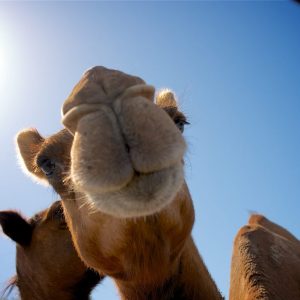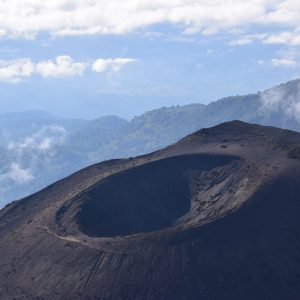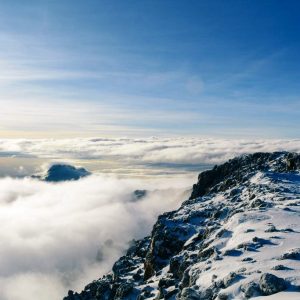12 Days Nothern Activities Culture Tourism Trekking
- Comfortable trekking and camping through breathtaking landscapes
- Enjoy one of the roughest and most fascinating landscapes in Africa
- Go on an exciting hunting trip with the Hadzabe bushman, a tribe of nomadic hunter gatherers
- Meet members of the Datoga tribe
- Experience the Maasai culture
- Climb Tanzania’s only active volcano, the sacred “Mountain of God” of the Maasai people
- Watch the sunrise from the summit of Ol Doinyo Lengai
Tour FAQs
- Overview
- Itinerary
- Circuit / Region
- Included Services
- Excluded Services
- Options
- Rates
- Best Time To Travel
- Packing Tips
- Notes
An hour’s drive west of Karatu is the largest of the slightly alkaline Great Rift Valley Lakes. The impressive crater highlands extend to the northeast, while the wide plains of the Serengeti stretch to the north. Only a few tourists visit Lake Eyasi. Anyone who takes the time is enthusiastic. The landscape, the vastness, the wildness, the reduction to the essentials and finally the life of the people, as we can no longer imagine in Western countries, leave no visitor cold. The area is inhabited by Bushmen, the Hadza and the Watindiga, who still hunt with bows and arrows and collect roots, tubers and fruits. Another tribe in this area are the Datoga, skilled farmers and craftsman collecting scaps of iron, which melt in ingots from which to obtain ornamental objects. In fact, they are skilled smiths and realize arrowheads and other objects that then they barter in exchange for honey and animal skins with the bushmen.
This part of Tanzania is characterized by volcanoes and is a region full of bizarre beauties, the active volcano Ol Doinyo Lengai, the flickering Lake Natron with its abundance of flamingos, the furrowed East African Rift Valley and the endless sand and stone deserts. The path leads around Ngorongoro crater rim, through vast grassland, later through scree deserts and between volcanic peaks. Occasional companions are zebras, ostriches, wildebeests, giraffes and gazelles. During the hike you will pass many Masai Bomas (villages). On Mount Makarot, the tour goes through a wonderful mountain forest, where there are many animal tracks to discover. Another highlight is the Empakaai Crater, which is slightly smaller than the Ngorongoro Crater, little visited and beautiful.
Climbing to the summit [2890 mt / 9481 ft] of Ol Doinyo Lengai, which is locally regarded as the sacred Mountain of God in the Maa Language, is possible without specific equipment but the ascent is challenging because the mountain is very steep. Mt. Ol Doinyo Lengai is the only known volcano in the world that erupts natrocarbonatite lava, a highly fluid lava that contains almost no silicon. Natrocarbonatite lava (most fluid lava) is also much cooler than other lavas. During the day most of this lava flows look like fluid black oil. Some feel the lava flows resemble mud like-flows. Natrocarbonatite lava turns white when in contact with moisture. During rainy periods, the lava turns white almost immediately whilst this whitening takes longer during the dry periods.
- Day 1: Arrival Kilimanjaro International Airport (JRO) or Arusha Airport (ARK)
Meet & greet by our Safari Driver and drive to your accommodation in Arusha.Meal plan: breakfast, lunch, dinner (depends on arrival time)
Possible Accommodations: Tulia Boutique Hotel & Spa (mid-range) or Arusha Gold Crest Hotel (mid-range) - Day 2: Arusha - Lake Eyasi
After breakfast you leave Arusha with picnic lunch and drive to Lake Eyasi to visit the Hadzabe and Datoga tribes as well as walk along the lake. Later in the day you proceed to the lake camp for dinner and overnight.Estimated driving distance: 3.5 h drive
Activities: culture walkingMeal plan: breakfast, lunch, dinner
Accommodation: Public Campsite or Kisima Ngeda Campsite - Day 3: Endamaga Gate/Misigiyo Valley
Early morning after breakfast you leave the camp and drive to Endamaga gate where you will be dropped off and start hiking from Endamaga gate for 6 to 7 hours up to Misigiyo Valley with game viewing and overnight at Misigiyo Valley in Ngorongoro Conservation Area full of wildlife.Estimated Walking distance: 6 – 7 h walking
Activities: Walking/HikingMeal plan: breakfast, picnic lunch, dinner
Accommodation: Misigiyo Valley Campsite - Day 4: Misigiyo Valley/ Makarot Mountain
After breakfast you leave Misigiyo valley with picnic lunch for a 6 to 7 hours hiking to Makarot camp. Later in the evening climb Makarot Mountain which will take 3 hours up and 1 hour down.Estimated Walking distance: 6 – 7 h walking
Activities: Walking/HikingMeal plan: breakfast, picnic lunch, dinner
Accommodation: Makarot Campsite - Day 5: Makarot Mountain/Seneto Rim
Early in the morning after breakfast you leave Makarot Mountain for 4 to 5 hours hiking up to Seneto rim campsite. Hot lunch with game viewing on route, walk around Ngorongoro crater rim.Estimated Walking distance: 6 – 7 h walking
Activities: Walking/HikingMeal plan: breakfast, lunch, dinner
Accommodation: Seneto Rim Campsite - Day 6: Seneto Rim/ Alayanai forest
Today after breakfast we leave Seneto rim with picnic lunch for 7 to 8 hours walk to Alayanai forest via Engutotoosumbat. The car support ends here, so we will start to use donkeys.Estimated Walking distance: 7 – 8 h walking
Activities: Walking/HikingMeal plan: breakfast, picnic lunch, dinner
Accommodation: Alayanai Forest Campsite - Day 7: Alayanai Forest/ Nainokanoka
After breakfast we leave Alayanai forest with picnic lunch and go for 6 to 7 h to Nainokanoka Village for dinner and overnight at Nainokanoka camp. Later in the day we visit Olmoti crater and Munge river waterfalls.Estimated Walking distance: 6 – 7 h walking
Activities: Walking/HikingMeal plan: breakfast, picnic lunch, dinner
Accommodation: Nainokanoka Campsite - Day 8: Nainokanoka/ Bulati
After breakfast we leave for 5 to 6 hours from Nainokanoka to Bulati, passing a few Maasai Bomas on our way. We will have picnic lunch midway to Bulati. We cross the Embulbul depression, a vast grassland with no trees, but many zebras can be seen grazing, wildebeests, raptors due to the many mole rat mounds found in the area. We arrive in Bulati early in the afternoon for rest and refreshments. Late afternoon Maasai Boma visit in the village of Bulati where we will spend the night.Estimated Walking distance: 5 – 6 h walking
Activities: Walking/HikingMeal plan: breakfast, picnic lunch, dinner
Accommodation: Bulati Campsite - Day 9: Bulati/ Empakai Crater
Today we will hike for 5 to 6 hours, change the environment from temperate grassland to montane forest zone on the crater rim. Plenty of spectacular panoramic views of the landscape. We have packed lunch midway on the trek. In the afternoon you will descend into the crater where you can see lesser flamingos who reside on the crater soda lake. The Caldera is 300m deep and 6kms wide. The trek is roughly 45 minutes down and an hour walk back up. Today you are sure to spot a profusion of animals including blue monkeys, buffalo, bush bucks, water bucks, and an extensive array of kaleidoscopic bird life. Today we will be camping right on the rim of the Empakai Crater.Estimated Walking distance: 5 – 6 h walking
Activities: Walking/HikingMeal plan: breakfast, picnic lunch, dinner
Accommodation: Empakai Campsite - Day 10: Empakai Crater/ Acacia Village
After breakfast, we will leave the Empakai crater and go for 6 to 7 hours trek to Acacia Village via Naiyobi village where you will stop for lunch. From Naiyobi we head down to Acacia Campsite. You will head out on a late afternoon walk to view the surrounding area and to take photos of the majestic Mt. Ol Doinyo Lengai, which is a Maasai name for “Mountain of God”. This mountain is unique amongst geologists because it is the only active volcano on Earth that erupts with a carbonatite, a type of igneous rock rich in carbonates such as calcite and dolomite.Estimated Walking distance: 6 – 7 h walking
Activities: Walking/HikingMeal plan: breakfast, lunch, dinner
Accommodation: Lake Natron Campsite - Day 11: Ol Doinyo Lengai summit and back to Lake Natron campsite
Today very early in the morning you drive to the base of the Ol Doinyo Lengai mountain to start the climb so as to gain as much height as possible in the cool of the morning reach at the summit during sunrise and spend some time there before coming down to the base of the mountain. From there clients will be transferred by jeep to the camp for shower and rest. Sun hats and a large water in-take are essential. Descend by the same route. Great care should be taken on the way down: loose volcanic gravel on bare rock makes it perilous going in places. Bringing trekking poles is very helpful.Estimated Trekking time: 8 - 11 h.
Activities: TrekkingMeal plan: breakfast, lunch, dinner
Accommodation: Lake Natron Campsite - Day 12: Half day tour at Lake Natron/Engaresero Village
After a delicious breakfast you leave with your local guide for a walking tour around Lake Natron. Lake Natron an alkaline lake that serves as the principal breeding site for three-quarters of the world’s population of Lesser Flamingos. Leave for an on route visit at a Maasai “Boma” village. You will have time to interact with Maasai people and learn their culture and day to day activities. After the tour and activities at Lake Natron we will return to the camp for hot lunch and preparation to drive back to Arusha.Estimated driving time: 6 - 8 h.
Activities: Game drivesMeal plan: breakfast, lunch, dinner
Accommodation: Tulia Boutique Hotel & Spa (mid-range) or Arusha Gold Crest Hotel (mid-range) - Day 13: Arusha/Departure
Today after breakfast we will transfer you to the airport for your flight back home or additional programMeal plan: breakfast
- Transport from and to your hotel/residence or airport/seaport
- All park fees, including mountain rescue fees, government taxes and all applicable fees and taxes
- Professional, English-speaking driver/guide, Maasai guide and cook, park ranger
- All accommodations and meals as mentioned in the itinerary. N. B. accommodation mentioned in the itinerary is dependent on availability at the time of booking; alternatives of a similar class may be booked instead
- All camping gear (if you are camping)
- Donkeys for transportation of your luggage, food, and water, and camping equipment
- Game drives and activities as per itinerary
- Safari base vehicle 4×4 Vehicle with open roof for game viewing (if applicable)
- Drinking water while on safari
- Driver’s salary and allowances and park fees for vehicle and driver
- Sleeping bag / mat
- International/national flights and visa fees
- Extras, personal expenses i.e. soft and alcoholic drinks, telephone, souvenirs, laundry etc.
- Travel, medical, injury and luggage insurance
- Flying doctor rescue services
- Government-imposed increases in taxes and/or park entrance fees
- Tips to the driver & guide
- Anything else not mentioned in the inclusions
- Optional activities not outlined on the itinerary
- Extension of the stay or additional program possible i. e. relaxing beach holidays on the Islands of Zanzibar or Mafia or at the East Coast of Tanzania or Game drives in the National Parks for example Lake Manyara or Tarangire National Park.
- The main rainy season is from late March to late May.
- The ideal travel time is from the end of December to mid-March with good visibility in the mountains.
- The large dry season from July to October is also suitable, but It can get cold when trekking in the highlands.
- The small rainy season in November / December brings somewhat more changeable weather.
- The best time to travel to Lake Natron is in the dry months from July to October. During this time, up to two million Lesser Flamingos usually live and breed at the lake.
- Please follow the list below to ensure your comfort. You will have a better vacation if you are prepared (recommendations for climbing Ol Dionyo Lengai)
- Sun hat
- sunglasses
- head torch
- buff or lightweight neck gaiter (for keeping out dust)
- rain shell
- light fleece shirt
- long sleeve t shirt x 2
- hiking trousers (zip off style are recommended, so you have shorts too)
- waterproof trousers
- socks x 3 pairs
- hiking shoes preferably with some decent ankle support
- walking poles
- gaiters for those that have low cut hiking shoes
- water bottles x 3, enough to hold 3 Liters
But please note that this list is not exhaustive!
- Usually our tours require a minimum of 2 persons to run. Single travelers can join a tour or ask us for a tailor-made safari.
Are you ready to explore Africa?
This itinerary is an example of tours we organize.
Contact us by email, WhatsApp or phone to create your individual trip or choose one of our itineraries without obligation!
-book now-














